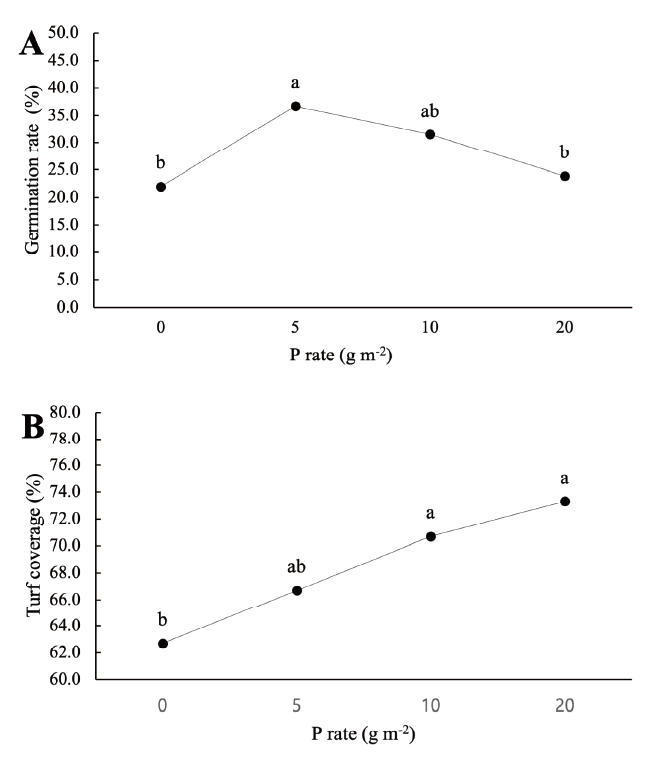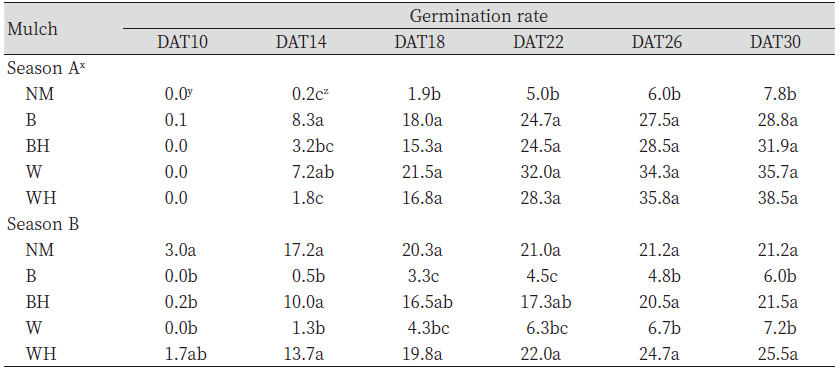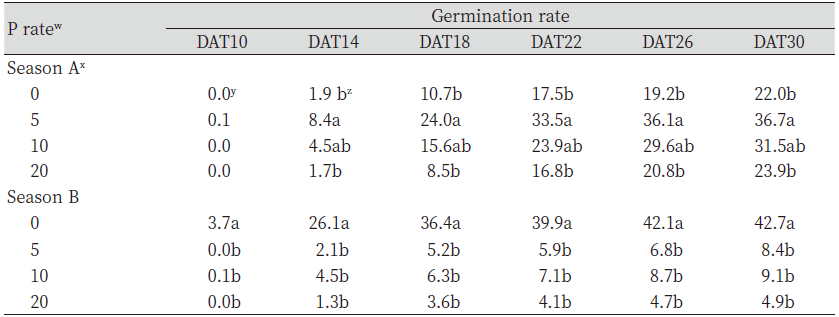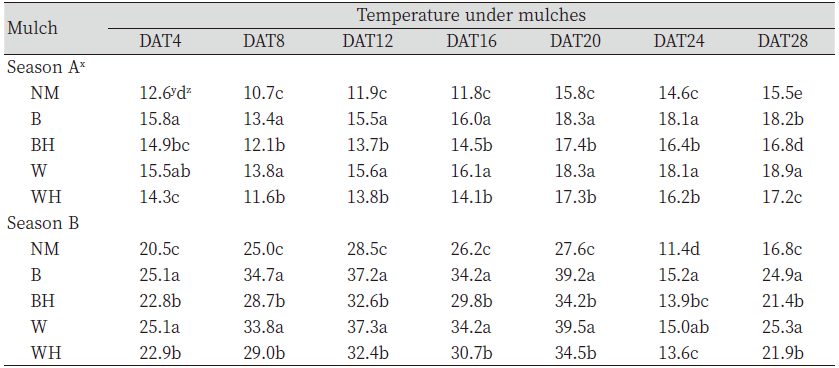Introduction
Kentucky bluegrass (Poa pratensis) is the most widely used among cool-season grasses for useful color, quality, and close-mowing tolerance. Disadvantages of Kentucky bluegrass are to require high irrigation and nutrient levels because of their shallow root system. When insufficient nutrients and water contents are provided to Kentucky bluegrass, it alleviates their growth under shade condition and lead to longer establishment time resulted from slow germination (Christians, 1998; Hall, 1996). Kentucky bluegrass is known to take 14 to 21 days for their germination which takes more time than most other cool-season grasses and it is comparable time compared to germination for warm-season grasses such as hulled bermudagrass (Cynodon dactylon), centipedegrass (Eremochloa ophiuroides) and zoysiagrass (Zoysia japonica) which take about 10 to 20 days for germination period (Samples and Sorochan, 2007). Turf establishment is defined as root and shoot growth from seed germination or vegetative planting needed to form a mature, relatively stable turf (Beard, 2004). Establishment is considered as turf coverage by visual evaluation reach 50, 75, 90% or more based on the purpose of study (Chang et al., 2014; Frank et al., 2002; Patton et al., 2010; Schiavon et al., 2013). Irrigation after seeding should be light and frequent to keep soli surface moisture. Water must be absorbed by seed to initiate germination progress and maintaining soil surface moisture can promote germination. (Beard, 1998; Turgeon, 1991). Polysaccharides, proteins, triglycerides, and salts of phytic acid in embryo of seed have to be hydrolyzed by water to start germination. Seed germination can be inhibited on the water stress (Koller and Hadas, 1981). Proper soil temperature ranges are 16 to 30℃ and 27 to 35℃ for germination of cool-season and warm-season grasses respectively (Beard, 1998). Larsen and Bibby (2005) reported that the germination time of Kentucky bluegrass requires more time than the germination time of other cool-season grasses such as red fescue and perennial ryegrass at all the temperature condition treated.
Mulch is defined as a material that is spread on the surface of the soil to protect the soil and young plants from soil erosion, soil crusting, freezing, and/or evaporation (Beard, 2004). Dudeck et al. (1970) measured soil water content during establishment period of smooth bromegrass on fill slopes and reported that mulches maintained soil water content of 24.7%. Roberts (1986) evaluated various materials and weight of mulches to maintain leaf moisture, root length, clipping weight, soil temperature and color at the spring. He reported that mulch of spunbonded polyester weighing 34 to 68 g m-2 had 10 to 20% more leaf moisture, up to 24% longer root length, up to 80% more clipping weight and up to 10℃ higher soil temperature than uncovered control plot. Patton et al. (2010) tested various mulch materials for establishment of bermudagrass, buffalograss (Bouteloua dactyloides), centipedegrass, seashore paspalum (Paspalum vaginatum), and zoysiagrass by measuring percentage of photosynthetically active radiation penetration. They reported that light intensity can be reduced by turf coverage depending on turf mulch materials.
Phosphorus (P) is well-known for energy storage and transfer which may affect germination and establishment. Low P levels may lead to immaturity of plant and the limited root system in the early growth stages (Christians, 1998). Frank et al. (2002) tested effect of nitrogen, phosphorus, and potassium for buffalograss establishment in Kansas, Nebraska and Oklahoma. They reported that P application enhanced buffalograss coverage about 10% compared to control plot in Nebraska and Oklahoma while the P applications in Kansas had no effect for buffalograss coverage. Zhu et al. (2018) applied two N levels of 0 and 100 kg ha-1 and four P levels of 0, 60, 90, and 120 kg ha-1 to evaluate quality and germination potential of smooth bromegrass. They found that final germination rate was over 93% regardless applied N and P. However, final germination rate from N rate at 0 kg ha-1 was higher than germination rate of bromegrass treated by P rate of 90 kg ha-1. Itoh (2002) applied two P levels of 0 and 44 mg kg-1 under two temperature condition of 8 and 20℃. He reported P application had more effects at 8℃ than 20℃.
Phosphorus application and mulch are commonly used during turf establishment period and have been reported for their benefits. However, interactions of mulch and P rate have been reported with limited research results and P effects under different temperature range for Kentucky bluegrass establishment is still vague. The objective of the study was to evaluate various phosphorus rates and turf mulches for establishment from Kentucky bluegrass seed.
Materials and Methods
Two laboratory studies were conducted in the condition of proper and relatively high temperature range for Kentucky bluegrass germination. The first laboratory study (the season A) was conducted from Jan. to Feb., 2020 with the condition of the air temperature range from 16 to 22℃ as proper temperature range for cool-season grasses. The second laboratory study (the season B) was conducted from Sep. to Oct., 2020 with the condition of the air temperature range from 19 to 45℃ as excessive temperature range for cool-season grasses. The field study conducted from Sep. and Oct., 2020 and the results were compared to the laboratory study on the season A of proper temperature range. The fields study had the air temperature range from 14 to 22℃.
Field study
The study was performed at the turfgrass research center in Hoseo University, Asan, South Korea (36°73/N, 127°08/E) on September 2020. Kentucky bluegrass ‘Midnight’ was used at the seeding rate of 10 g m-2. Each plot size was 0.8×0.5 m. Four different mulch materials and no mulch were treated to cover Kentucky bluegrass after seeding to retain soil moisture and temperature of soil surface. Black and white poly-vinyl chloride (PVC) film were used as material for mulch. The 15% pore space were made with holes of 0.4 cm diameter on black and white PVC to increase light transmittance. Before seeding, phosphate was applied at the rate of 0, 5, 10, and 20 g m-2 using Fused Magnesium Phosphate, 0-17-0 (PUNGNONG, Seoul, Korea). All treatments were described in Table 1. Nitrogen was applied at the rate of 5 g m-2 at all plots using Urea, 46-0-0. Irrigation was supplied as required to maintain soil surface moisture. Each mulch was analyzed using the optical microscope (BX51, OLYMPUS, Tokyo, Japan) and spectrometer (USB4000-XR1-ES, Ocean Insight, Florida, USA) to measure light transmittance (%). Percent coverage of Kentucky bluegrass has been visually rated on a scale of 0 to 100% every 2 days since the first treatment. Time Domain Reflectometry (Field Scout TDR-300, Spectrum Technologies Inc., Illinois, USA) was used to measure volumetric water content (%) in the soil at the depth of 5 cm every 4 days. Soil surface temperature was measured for every 4 days by Infrared Thermometer (IRT207, General Tools and Instruments, New York, USA).
Laboratory study
Seed germination test was performed in Plant & Environment Lab. at Hoseo University, Asan, South Korea according to ISTA protocol (ISTA, 2015). Two indoor experiments were performed for the different temperature condition. The first study (season A) was conducted from Feb. to Mar., 2020 under the condition of the air temperature ranged from 16 to 22℃ as proper temperature range for cool-season grass growth. The second study (season B) was conducted from Sep. to Oct., 2020 under the condition of the air temperature ranged from 19 to 45℃ as excessive temperature range for cool-season grass growth. Petri dishes of 9 cm diameter were lined with whatman filter paper (GE Healthcare, Chicago, USA) and absorbent cotton (Sangkongyanghang, Yongin, Korea) as growth media for Kentucky bluegrass seeds. The fifty seeds were placed in each petri dish. Mulch materials and P rate treatments were applied to the Kentucky bluegrass seed with the same methods in the field study. Because the amount water loss is different in each mulch treatments, irrigation was supplied as required to avoid drying out its seeds. Surface temperature of each petri dish was measured as the same method used in the field test. Number of seed germination was counted every day and germination percentage was calculated based on number of seed germinated.
Randomized complete block design was used for the experimental design with 3 replications with 20 treatments. Treatment differences were analyzed by the Proc GLM procedure. Treatment means were separated by Fischer’s protected least significant difference (LSD) at a 0.05 probability level. All statistical analyses were analyzed by SAS (SAS Institute, 2003).
Results and Discussion
Significant differences between two laboratory studies were found (data not shown). There are significant differences for mulch material main effects for both season A and B (Table 2). The mulch materials of black PVC film (B) and white PVC film (W) had the greatest or equal to the greatest germination rate at the season A. After DAT14 in the season A, all mulch materials had no differences and higher germination rate than no mulch (NM) of control. On the contrary, the NM had the greatest or equal to the greatest germination rate in the season B which had the condition under excessive temperature range for cool-season grasses. Although the NM had no differences with the black PVC film with holes (BH) and white PVC film with holes (WH), it had 15.2 and 14.0% more germination percentage than the B and W mulch at the final rating date. The B and W mulch had the lowest or equal to the lowest germination rate at the season B. Significant differences for P rate main effects on germination percentage were found during the season A and B except DAT10 on the season A (Table 3). In the season A, the P rate of 5 and 10 g m-2 had the greatest or equal to the greatest germination percentage. In the condition of the season A which had temperature range from low to optimal temperature range for the germination of cool-season grasses, P rate had positive effects on germination percentage when the rate is lower than 20 g m-2. Numerous research results have been reported on the positive responses of cool-season turfgrass seedings to P applications (Turner and Hummel, 1992). Most researches reported are conducted under the optimal temperature range for cool-season grasses. However, the zero P rate had the greatest germination rate in the season B which is higher temperature range than optimal temperature range for germination of cool-season grasses. Based on the results of the study, temperature range may be related to P rate effects on germination rate of Kentucky bluegrass. Giolo et al. (2017) reported Kentucky bluegrass germination on high temperature range which is higher than 39℃ resulted in 0 to 50% reduction on germination rate. In the season B, all mulch materials had 33.6 to 37.8% lower germination rate than the zero P rate at the final rating date. All mulch materials may lead to increase growth media temperature under mulch compared to the NM of no mulch. It is supported by the previous research. Patton et al. (2010) reported the use of mulches can lead to high temperatures where grasses are difficult to grow, depending on the type of cover. Our results also indicated that the B and W mulch had the highest or equal to the highest temperature of growth media under mulch during the period of the study (Table 4). The B mulch had 2.5 to 4.2℃ higher temperature than the NM of no mulch when the temperature range was optimal for germination of cool-season grasses. When the temperature was excessive for germination of cool-season grasses, the B mulch had 2.5 to 4.2℃ higher temperature than the NM of no mulch 3.8 to 11.6℃. The BH and WH also had higher temperature than the NM of no mulch during the season A and B. Based on the results, mulch increase temperature of growth media under mulch and it lead to positive effects for germination rates of Kentucky bluegrass when air temperature is optimal or lower than optimal range. However, P applications and mulch materials of the B and W had negative effects for germination rates when air temperature is higher than optimal range. At the final rating day, the P rate of 5 and 10 g m-2 had the greatest germination rate on the season A, while the zero P rate had the greatest germination rate on the season B (Fig. 1). Under the condition of proper temperature range, P applications have positive effects on germination of Kentucky bluegrass, but it showed negative effects on germination when the air temperature increase higher than proper temperature range. This result is supported by the previous researches. Itoh (2002) estimated that P uptake rate by barley under the condition of two different temperature. He reported that the effect of P application can be larger when the temperature condition is low compared to high temperature conditions. The P uptake rate was 17 to 60% higher under low temperature conditions than under temperature conditions. Sheppard and Racz (1984) also reported that the extractability of P was reduced as temperature increase and this effect persist for 48 h. Under the condition of excessively high temperature, the P uptake and extractability are related to temperature conditions. The germination rate may be also affected by P application under temperature range based on the results the study.
In the field study, no interactions between mulch materials and P rate were found for turf coverage during the study (data not shown). The BH mulch had the greatest turf coverage from DAT18 to DAT42 although the B mulch had the greatest turf coverage on DAT12 (Table 5). The NM of no mulch and the WH mulch had the lowest or equal to the lowest turf coverage throughout the study period. In the laboratory study on the season A which is conducted under proper temperature range, all mulch materials had greater germination rates than the NM of no mulch due to temperature increase by mulch treatments (Table 2 and Table 4). However, although significant differences were found for mulch main effects on soil surface temperature under mulch in the field study, no consistent relations were found on mulch material effects on soil surface temperature under mulch in the filed study (Table 6). The W mulch had the highest or equal to the highest temperature during the field study while the B mulch had lower temperature than the NM of no mulch at DAT36 and DAT40. The laboratory study on the season A and the field study were conducted to be compared for germination rate and Kentucky bluegrass coverage under proper temperature range of cool-season grasses. Based on the results, the effects of mulch materials to temperature of growth media under mulch were not consistent for both the study on the season A and the field study. The B and BH mulch which are black color had the greatest and the second greatest germination in the field study, respectively. In comparison, the black and white mulches had no differences for germination rate from DAT18 to DAT30 in the study on the season A (Table 2). These differences between the study on the season A and the filed study may resulted from other factors such as light. Several research studies have been reported for relation between germination rates and light condition and concluded that that light condition can inhibit seed germination of plant (Barrero et al., 2012; Hilton and Bitterli, 1983). Rossini et al. (2019) tested six shade treatment including 30, 50, 70, 90, and 100% for germination of cool-season grasses. They concluded that shade condition had more germination rate than 0% shade of control plot. Meadow fescue (Festuca pratensis) and annual ryegrass (Lolium multiflorum) had the greatest germination rate of 90% in shade treatment. In our study, The B mulch had 3% light transmittance at the wavelength 400-700 nm and the BH mulch had 85% shade with 15% pore space. Based on the study, turf coverage had greater in the B and BH mulches than white color mulches in the field study due to light screen by soil. However, the light can directly reach Kentucky bluegrass seeds without any interference in the laboratory study, but they are only screened by mulch treatments. It may lead to the results differences between germination rate in the laboratory study (the season A) and the filed study.

Fig. 1. Mean germination rate of ‘Midnight’ Kentucky bluegrass for phosphorus (P) rate at the final rating date. Each mean was calculated from 15 observations (three replications×no mulch and four mulch materials). (A) Germination rate was measured from the laboratory study on season A that was performed under the condition of air temperature ranged from 16 to 22℃ as proper temperature range for cool-season grass growth. (B) Germination rate was measured from the laboratory study on the season B that was performed under the condition of air temperature ranged from 19 to 45℃ as excessive temperature range for cool-season grass growth. a, b: Means with the same letter within P rates are not significantly different according to Fisher’s LSD (P =0.05).
There are significant differences for P rate main effects on turf coverage in the field study. The P rate of 10 and 20 g m-2 had the greatest turf coverage during the field study while the P rate of 5 and 10 g m-2 had the greatest germination rate in the study on the season A (Fig. 2). It may be related to nutrient damage by concentration. Carter (1967) reported that damage by chemical fertilizers on seedling establishment can occur when soil moisture content is low. Soil water contents have a major impact on the effect of fertilizers in contact with the seed. In the condition of the field study, fertilizer damage can be induced depending on the concentration of P rate and soil water contents. However, our results indicated that mulch materials and P rate didn’t have the effects for soil water contents (Table 7). In the condition of the laboratory study, P fertilizer can contact Kentucky bluegrass seeds directly regardless of water contents because of small area of 9 cm diameter petri-dish. It may result in negative effects by the P rate of 20 g m-2 on germination rate which is excessive concentration for seed germination of Kentucky bluegrass. If soil water content is suitable for seed germination, the high P rate is more effective than low P rate. Chang et al. (2014) reported that the highest P rate had the greatest or equal to the greatest P effects to reach 50% coverage of Kentucky bluegrass compared to other cool-season grasses. Our results indicated that the highest P rate had the greatest turf coverage and no P rate effects were found on the soil water contents in the field study (Fig. 2).

Fig. 2. Mean germination rate and turf coverage of ‘Midnight’ Kentucky bluegrass for phosphorus (P) rate at the final rating date. Each mean was calculated from 15 observations (three replications×no mulch and four mulch materials). (A) Germination rate was measured from the laboratory study on season A that was performed under the condition of air temperature ranged from 16 to 22℃ as proper temperature range for cool-season grass growth. (B) Turf coverage was measured from the field study that was performed under the condition of air temperature ranged from 14 to 22℃ as proper temperature range for cool-season grass growth. a, b: Means with the same letter within P rates are not significantly different according to Fisher’s LSD (P =0.05).
Phosphorus is well-known for seed germination and root growth. However, low P fertilization programs have been promoted because fertilizer programs are primarily based on the application of nitrogen (N) while P in most cases is applied based on a pre-determined ratio of N:P2O5 although soil P level is excessive sufficient for turfgrass. Lee et al. (2013) reported that when transplanting the sod to a low P soil, the turfgrass may not respond with higher quality or increased growth response to P application, thus P fertilizer applications may be unnecessary for three years. Waddington et al. (1978) also found that P applications had little effect on creeping bentgrass growth on a low P soil. Fertilization programs with the reduction or elimination of P applications is a more recent trend. In addition to this trend of P application, the results of the study indicated that P application resulted in negative effects on germination of Kentucky bluegrass seeds when the air temperature is higher than optimal range for cool-season grasses and mulch material can lead to temperature increase which may inhibit Kentucky bluegrass germination.









